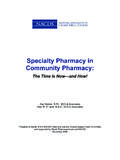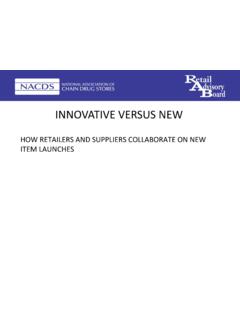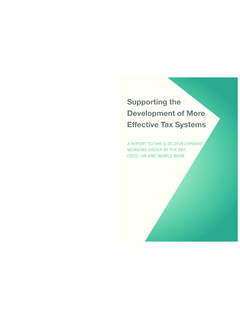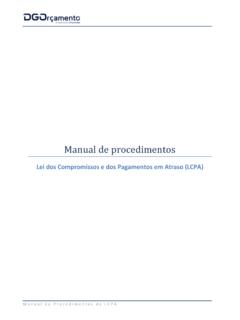Transcription of A Comprehensive Guide To Retail Out-of-Stock …
1 A Comprehensive Guide To Retail Out-of-Stock Reduction In the Fast-Moving Consumer Goods Industry A research study conducted by: Thomas W. Gruen, , University of Colorado at Colorado Springs, USA. And Dr. Daniel Corsten, IE Business School Madrid A Comprehensive Guide To Retail Out-of-Stock Reduction In the Fast-Moving Consumer Goods Industry A research study conducted by: Thomas W. Gruen, , University of Colorado at Colorado Springs, USA. And Dr. Daniel Corsten, IE Business School Madrid This study was funded by a grant from the Procter & Gamble Company Acknowledgements Supporting Trade Associations: Grocery Manufacturers Association Food Marketing Institute National Association of Chain Drug Stores Partner Academic Institutions Technical Eindhoven University of Technology, TU/e Retail Operations Group, The Netherlands MIT.
2 Special thanks and recognition for his significant contributions to this report: Brackman, Global Retail Presence Manager, Procter & Gamble Company Special thanks to the data partners who contributed significantly to this report Copyright 2007 by the Grocery Manufacturers Association (GMA), Food Marketing Institute (FMI), National Association of Chain Drug Stores (NACDS), The Procter & Gamble Company (P&G) or the University of Colorado at Colorado Springs. All rights reserved. No part of this publication may be reprinted or reproduced in any way without express consent from GMA, FMI, NACDS, P&G or the University of Colorado at Colorado Springs.
3 Contact for permissions: ISBN: 978-3-905613-04-9. Table of Contents Executive Summary i-vi 1-6. Overview, Objectives, and Key 1. What is an Out-of-Stock ?..1-3. Guide to Using this Chapter 1: Understanding the Total Cost of 7-12. 1-1. Introduction and Overview With All of This Technology, Why Isn't Availability Higher?.. 7. 1-2. A Generally Unrecognized Problem: Costs of OOS > Lost 1-3. Root Cause Analysis Drives a Distinction Between Store and Shelf OOS Conditions .. 9-10. 1-4. We Know How Consumers Respond to OOS Conditions ..10-11. Chapter 2: Understanding OOS Through 13-23.
4 2-1. Understanding the Measurement and Identification of 2-2. Focus on the Items that Cause the Majority of OOS: There Really Aren't Very Many Fast 2-3. Viewing OOS Chapter 3: Lowering OOS Rates Our Hypotheses and Related 25-40. 3-1. Ordering What You Need When You Need It: The Case for Item Data 3-2. Ordering What You Need When You Need It: The Case for Inventory 3-3. Demand Forecasting 3-4. Having the Goods Arrive When You Need Them ..32-34. 3-5. Making Room on the Shelf: The Case for Demand-Based Planograms ..34-36. 3-6. Knowing Where Everything Should Be: The Case for Planogram Compliance.
5 36-38. 3-7. Knowing Where Everything Should Be: Keeping the Shelves Chapter 4: Getting and Keeping Lower Levels of 41-48. 4-1. The Ability to Measure Provides the Ability to 4-2. Taking 4-3. A Comprehensive Approach to Reducing OOS Events, Duration, and 4-4. Practical Steps to Address OOS of High Demand 4-5. Bringing It All Together and Looking 49-56. Authors' 57-58. A Comprehensive Guide To Retail Out-of-Stock Reduction In the Fast-Moving Consumer Good Industry Executive Summary Overview Out of Stock Definition is Clarified This research report provides a Comprehensive This report catalogs the meaning of various out of stock examination of the foundational knowledge, measurement rates that have been reported in previous studies.
6 We hope approaches, and strategies used to reduce Retail out-of- to avoid further confusion caused by vague reporting of the stocks (OOS) in the fast-moving consumer goods (FMCG) data collection and calculation methodology used to establish industry. Its objective is to provide a Guide to FMCG the rate. The three common types of measurement (1). retailers that seek to reduce their costs associated with OOS audit of physical inventory, (2) analysis of point of sale data items, while simultaneously enhancing shopper satisfaction (POS), and (3) use of perpetual inventory data (PI) each with sustained lower levels of OOS.
7 As outlined in Exhibit measure different aspects of OOS, and thus report different A, this research report: OOS rates. Further ambiguity arises from differences in 1. defines Retail OOS metrics to resolve the confusion what is counted (a) instances, (b) units sales losses, or surrounding previously reported OOS rates and shows (c) monetary sales losses. Generally, audits count instances the total costs of OOS, beyond lost sales (Chapter 1); observed at a point in time (when the audit took place). 2. compares the three basic approaches to the measurement PI data is typically used to count instances over some time of OOS, illustrates how OOS measurement can be interval (perhaps a week).
8 POS data analysis can yield a directly linked to root causes, and shows where most broader set of measurements including each of (a), (b), and OOS sales losses occur (Chapter 2); (c) above. 3. systematically examines seven causes of OOS, from forecasting to merchandising, showing the impact on We make a clear delineation between an OOS event overall OOS levels of addressing each (Chapter 3); and (an instance of an item being unavailable for sale as 4. provides a flexible approach to reduce OOS that intended), and the attributes of the OOS event, and retailers can easily adopt, can be effective even with low statistical descriptions of collections of OOS events initial level of resource commitment and can scale with (expressed as an OOS rate).
9 These attributes include: increased resource commitment (Chapter 4). 1) number of occurrences over time, 2) number of simultaneous occurrences, 3) duration, 4) shelf availability, Our extensive research shows that retailers can 5) lost unit sales, 6) lost monetary sales, and 7) number of sustain OOS reductions below the industry average of customers impacted. percent. The core requirement is the development of an effective measurement system one that is accessible, Store vs. Shelf OOS Perspective is Established timely, inexpensive, reproducible, and generally undistorted.
10 One of the keys to efficiently reducing OOS is a clear Without this core ability, it is impossible to determine delineation between types and their distinct underlying progress, assign responsibility for tasks, and maintain causes. From the retailer perspective, the three main OOS. accountability for results. When the measurement stops, types are the distribution center OOS, store OOS, and shelf people go back to their old way of operating, and the OOS OOS. While much of the industry is focused on distribution return to their previous levels. OOS, this report focuses on store and shelf OOS types.








